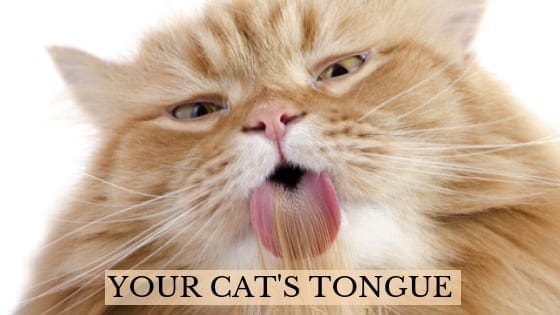
Do you remember the very first time you were licked by a cat? If you had been used to the smooth sensation of a dog’s tongue then it was probably quite surprising to experience the rough feel of a cat’s tongue. If, however, you’ve lived with cats for many years, you probably don’t even think twice about that sandpaper sensation. Here are some facts about the cat’s tongue:
The Tongue is Covered with Papillae
The tongue of a cat has tiny, backward-facing barbs (papillae) on it and they’re the things that create that rough sensation. The barbs serve several important functions. They make it easier for a cat to rasp the meat from the bones of prey. The barbs also aid in grooming as they collect dirt, debris, and loose hair from the cat’s coat. The downside to the backward-facing barbs though is that anything the cat collects on her tongue will usually end up getting swallowed and that’s how your cat may end up with lots of hairballs. The barbs on the tongue also make it dangerous should cats get some yarn, string or tinsel in their mouth because they won’t be able to spit it out.
Grooming for Survival
After cats have eaten prey they will groom to remove all traces. This is an important survival strategy because cat don’t want to alert any other prey in the area to their presence. Additionally, cats are small enough so they are not only predators but potential prey as well. Removing traces of a fresh kill is critical for the cat’s safety.
Grooming for Comfort
Your cat will also use their tongue to groom for temperature regulation to help keep cool through evaporation.
Grooming for Behavior
Grooming is also a displacement behavior and cats may use their tongue to groom areas of the body if they feel stressed or anxious. Repeated grooming in the same area can actually cause bald patches. Cats will also use their tongue for social grooming. You may notice this if you have a multicat environment and you see two cats engaging in allogrooming.
Taste Buds
The cat’s tongue has fewer taste buds than a human has and interestingly, the cat, in general doesn’t have a taste for sweets. We probably create that habit and desire in our cats by feeding inappropriate foods.
Food Texture Preference
The texture, size and shape of food are important to cats and they may like or reject a certain food based on how it feels on the tongue.
Drinking Water
It used to be that experts thought cats lap up water by curling the tip of the tongue into a makeshift spoon but recent research has shown that the cat actually drinks by curling the upper side of the tongue downward and then darts it across the surface of the water at a remarkably fast speed. This causes a column of water to rise up and the cat closes his mouth just in time to collect it before gravity allows the water to fall back down. The research was done by a group from the Massachusetts Institute of Technology, Virginia Polytechnic Institute and Princeton.
Need More Information?
For information on Pam’s Think Like a Cat behavior and training techniques, refer to her best-selling books. Pam’s books are available in bookstores and online. We’ve included links to Amazon here on our website.
If you have a question about your cat’s behavior or health, contact your veterinarian. This article is not intended as a medical diagnosis nor is it a replacement for your cat’s regular veterinary care. This article is for general information purposes only.



